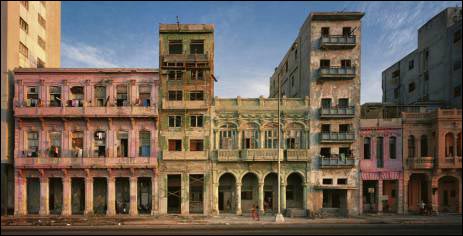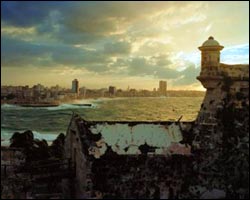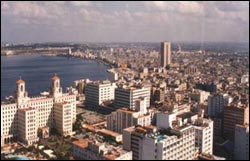 |
|
Photo courtesy of Robert Polidori
|
A comprehensive strategy for promoting
culturally sensitive growth in a Post-US-embargo Cuba
Why Havana?
Cuba is a country with a rich cultural identity, an impressive architectural urban heritage, highly educated people with advanced social ideas, and very much in need of economic growth. Notwithstanding the US embargo, foreign investment in Cuba is leading economic development in ways that have a direct impact on the nation's architecture. With the U.S. economic embargo likely to be lifted in the not-too-distant future, Cuba is fast approaching the time when it must evaluate its role and identity as a partner in the global economy. Like most Cubans, UI is deeply concerned about the preservation of the country's built environment during this period of impending change.
What will become of Cuba after the US Embargo is lifted?
Once the U.S. embargo ends, the pressures on Cuba to accept additional economic investment, regardless of its implications for the urban fabric and heritage, will be enormous. Projections indicate that the number of visitors to Cuba will skyrocket from 2 to 12 million a year. Like other countries in this position, Cuba is facing the dilemma of how it can accept new economic investment and growth in ways that are compatible with its cultural heritage and identity without losing its magic as a unique, culturally rich country. All of Cuba's cities will face these pressures, but Havana will be especially affected. While UI is focusing on Havana as a pilot project, representatives from other cities in Cuba will be involved in our Cuba project.
Havana: an historic city emerging from a time capsule
Havana is in far better shape than most historic cities around the world because it avoided many of the poorly conceived urban design trends of the last 40 years. Havana does not have major shopping malls, elevated highways, segregated cul-de-sac neighborhoods, and endless impersonal office buildings. For many, discovering Havana is like uncovering a "lost city," a fascinating, preserved city from another era, but one that is desperately in need of repair. With the lifting of the US embargo, Havana will undoubtedly become a prime target for new investment.
The restoration of Old Havana: the brilliant work of the City Historian
While many old structures still await refurbishing, enormous progress has been made to save this part of the city. The brilliant restoration being accomplished there by the Office of the Historian of the City of Havana today provides a textbook example for preservationists around the world. The success in restoring Old Havana's buildings is consistent with the City Historian's plan to turn it into a "living city." This sensitive restoration will benefit both the people who live and work there and the tourists who flock there for a glimpse of the Cuban way of life.
Retaining the distinct identity of the rest of the city
Outside of Old Havana, the remainder of the city's commercial and residential neighborhoods features a wide range of architectural styles — colonial, art deco, eclectic, and modern movement — and a few international and sometimes inappropriate hotels and housing projects. The Cuban architecture and planning community attributes great significance to their existing buildings and neighborhoods, which are in need of repair and often surrounded by future development sites. Preserving the legacy of these "newer" old buildings is one of the added complexities Cuban architects and preservationists will face as they plan for the future. How to create an atmosphere for sensitive growth and development in Havana is the ultimate challenge. And the creation of a new "Cuban" urban design and planning aesthetic that respects the context of the city while fostering creativity is vital to the preservation of Havana's distinct identity.
Cuba Project Launch — Havana, Cuba
February 21-24, 2003
The Office of the City Historian (OHCH)
Casa de las Américas
The Group for the Comprehensive Development of the Capital (GDIC)
The Institute of Physical Planning (IPF)
Physical Planning of the City of Havana (DPPF)
Faculty of Architecture, Ministry of Higher Education (ISPJAE)
The Housing Institute (INV)
Ministry of Construction (MICONS)
Front for Projects (Frente de Proyectos), MICONS
Ministry of Tourism
Landmarks National Commission (CNM)
Center for the Conservation, Restoration and Museology (CENCREM)
Ministry of Foreign Relations (MINREX)
National Union of Construction Architects and Engineers (UNAICC)
National Union of Cuban Writers and Artists (UNEAC)
Cuban Commission of UNESCO
 |
|
Photo courtesy of Robert Polidori
|
|
Our full website is currently under construction. Please contact us for more information about our organization and let us know how you'd like to get involved.
|
top of page
|
 |



